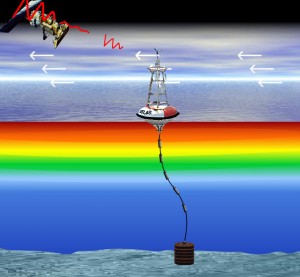What an On-Again, Off-Again El Niño Means For Texas

Photo by Mose Buchele
For El Nino to fully appear, the ocean temperature must enter a feedback loop with the atmosphere.
Earlier this year Lower Colorado River Authority meteorologist Bob Rose, liked what he was seeing in the forecast.
“I’m optimistic that we will get into a pattern of above normal rainfall this fall continuing into next winter and possibly into next spring as well,” he said in April.
But since then things changed.
After much ado, the El Niño predicted by many meteorologists hasn’t quite showed itself in the form rainfall yet. While there’s still a chance it could strengthen before the summer’s end, it’s not likely it will meet its initial forecasted fury.
“El Niño, while it looked like it was really starting to ramp up, and would really start to develop in September. It actually took a pause in July,” he says.
We often talk about El Niño like it’s a single, identifiable event, but it’s a really series of things – a pattern that can result in wet weather in North America. What got us so excited in the spring was the first piece in that pattern: The temperature of the tropical Pacific Ocean started to warm.
We knew because of the Tropical Atmosphere Ocean project, a network of buoys in the Pacific.

Credit Courtesy of NOAA
An image of the TOA system from the National Oceanic and Atmospheric Administration.
“They’re actually anchored buoys out in the deep in the ocean which is a technological feat,” says John Neilsen-Gammon, the State Climatologist of Texas. “They were put in because, well, back in the ‘80s we discovered, ‘Gee, this El Niño thing is important. We better figure out what’s going on!’”
So, this spring the buoys were picking up a nice big bulge of warm water heading east, which made it to the surface of the Eastern Pacific, warming up temperatures by as much as a degree or a degree and a half, Neilsen-Gammon says.
That sets the stage for the next step –when the warmer surface water engages with the atmosphere.
“Thunderstorm storm activity has to respond to that and move from where it normally is in the western pacific back to the east,” says Neilsen-Gammon.
He calls it a feedback loop, “I mean the normal thing that people think about when they think about positive feedback is when you have so a microphone that’s close to a speaker.”
When the sound is generated the microphone picks it up. Then the sound comes out through the speaker. It gets picked up by the microphone again. Then back to the speaker in an ever increasing echo and amplification.

Photo courtesy of Texas A&M University
John Nielsen-Gammon, the state climatologist, says Texas is facing a 50-50 chance of being in another drought of record.
“So that’s sort of what’s going on here with the ocean. You get the signal of warm water that comes up from the surface. And if the atmosphere picks up that signal and responds to it. Then that reinforces that signal in the ocean then everything gets stronger and stronger.”
Except, this year, that didn’t happen.
“I was a little bit disappointed. I don’t know if that’s the right word. I was intrigued when this August those water temperatures started to cool off,” says Rose.
Something similar happened in happened in 2012. “What we saw in that year was the water temperatures did warm up,” he says. “But there was nothing there to help sustain that warm water into the fall period. And the trade winds reversed and we started seeing cooler waters [coming] in and everything just sort of collapsed.”
That’s two times in three years where the pattern has fallen apart. So, could climate change be messing with El Niño?
“The answer is absolutely yes! It could be influenced,” says Neilsen-Gammon in response to the question. “Of course the next part of the answer is going to be really disappointing, we don’t know which direction climate change is going to influence things.”
Climate change could make El Niño more likely, or less likely. Right now the models just aren’t conclusive. Neilsen-Gammon says a definitive answer could come in about five years.
And in the case of this year, don’t count El Niño out just yet. The waters in the pacific have started warming again. There’s still around a 65 percent chance of a weak or moderate El Nino forming by the end of the year.It’s not as strong as many were hoping, and it means some parts of the country, like California, likely wont get the massive rainfall necessary to pull them from drought. But, according to Bob Rose, the strength of an El Niño doesn’t matter so much to Texas, even weak ones often bring rain here.
He’s still predicting above normal rainfall starting in the fall and through the winter.

